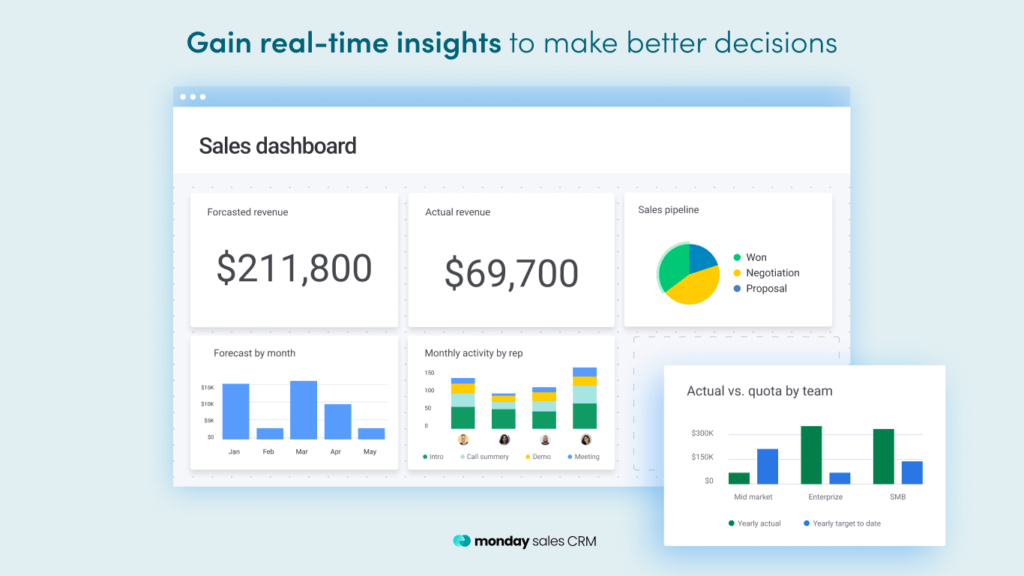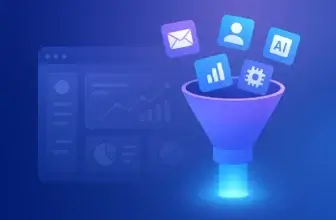
Introduction
A high‑performing sales pipeline is your roadmap for converting leads into loyal customers. It offers a clear view of where every prospect stands in your sales process and what it will take to move them forward. Unlike a sales funnel, which measures conversion rates at each level of the buyer’s journey, your pipeline provides day‑to‑day insights that help you forecast revenue, prioritize tasks, and identify bottlenecks. In fiercely competitive B2B SaaS and CRM markets, a well‑structured pipeline is the foundation for predictable growth.
Understanding Sales Pipelines
At its core, a sales pipeline is a visual representation of the steps a potential customer takes from initial contact to post‑sale follow‑up. Each stage of the pipeline corresponds to a specific milestone in the buyer’s journey and outlines the tasks your team must perform to move the prospect forward. When managed correctly, your pipeline helps you:
- Forecast revenue accurately by understanding how many deals are in progress and their likelihood of closing.
- Allocate resources efficiently, focusing on the opportunities most likely to convert.
- Improve team alignment by giving everyone a shared view of the sales process.
Key Sales Pipeline Stages
While every business can customize its pipeline, most B2B and SaaS pipelines share seven core stages:
- Prospecting (Lead Generation) – Identify and attract potential customers through marketing campaigns, referrals, and outbound efforts.
- Lead Qualification – Assess whether a lead matches your ideal customer profile. Use criteria such as budget, authority, need, and timeline to ensure they have the potential to buy.
- Meeting/Demo – Schedule a call or demonstration to understand the prospect’s pain points and showcase how your solution addresses their needs.
- Proposal – Present a detailed proposal or quote that includes pricing, scope, and terms tailored to the prospect’s requirements.
- Negotiation – Discuss objections, refine terms, and address concerns. The goal is to reach an agreement beneficial to both parties.
- Closing – Finalize the sale, secure contracts and set the stage for onboarding.
- Retention/Expansion – Nurture the customer relationship post‑sale, ensuring they achieve value, and exploring upsell or cross‑sell opportunities.
Understanding these stages helps you design consistent processes, track progress, and coach your team effectively.

Sales Pipeline Stages and Their Importance
Prospecting: Casting the Net
In the prospecting stage, you generate interest and fill the top of your pipeline. This involves inbound marketing (blogs, SEO, webinars) and outbound activities (cold calls, LinkedIn outreach). Focus on targeting leads that fit your ideal customer profile (ICP). Avoid trying to reach everyone; casting a wide net wastes resources and clogs your pipeline with low‑quality leads.
Lead Qualification: Separating Signals from Noise
Not every prospect is worth pursuing. During qualification, determine whether a lead is ready to buy and whether they have the authority and budget to do so. Use frameworks like BANT (Budget, Authority, Need, Timeline) to score leads. Effective qualification prevents unqualified leads from slowing down your pipeline and helps your team focus on high‑value opportunities.
Meeting/Demo: Showcasing Value
Once you qualify a lead, schedule a meeting or demo. Your goal is not to deliver a generic pitch but to tailor the conversation to the prospect’s specific challenges. Start by summarizing what they will see, demonstrate your solution in action, and wrap up with a recap that highlights outcomes. Encourage prospects to participate by asking questions and addressing concerns. This interactive approach builds trust and shows that you understand their needs.
Proposal: Presenting a Tailored Offer
In the proposal stage, put forward a comprehensive offer outlining price, services, and terms. Customization is crucial—generic proposals feel impersonal and can stall deals. Include case studies, ROI estimates and implementation timelines to help the prospect visualize success.
Negotiation: Achieving Win‑Win Agreements
Negotiation is where deals can be won or lost. Prepare thoroughly by knowing the prospect’s objectives and potential objections. Stay calm, trade concessions rather than giving them away, and be prepared to walk away if the deal doesn’t align with your business goals. Effective negotiators often close at higher rates and protect margins.
Closing: Sealing the Deal
Closing formalizes the agreement. Ensure contracts are clear, legal requirements are met, and payment terms are understood. Prompt communication and a seamless handoff to implementation set the tone for a positive customer experience.
Retention and Expansion: Sustaining Growth
The sale is only the beginning. Retention involves delivering on promises, providing support, and ensuring customers achieve their desired outcomes. High retention rates lead to upselling and cross‑selling opportunities. A mere 5 % increase in retention can boost profits significantly. Maintain regular communication, collect feedback, and identify ways to expand the relationship.
How to Build a High‑Performing Sales Pipeline
Creating a high‑performing pipeline requires a systematic approach. Follow these steps to establish a foundation for predictable growth.
Identify Your Ideal Customer
Start by defining your Ideal Customer Profile. Analyze your existing clients to identify patterns in company size, industry, budget, and pain points. Use market research, web analytics, and customer interviews to refine your ICP. When you know who you’re targeting, your prospecting becomes more efficient and your pipeline stays focused on high‑value opportunities.
Define Stage Criteria and Standardize Processes
Document clear entry and exit criteria for each stage. For example, a lead moves from qualification to meeting once they have expressed interest, confirmed budget availability, and identified decision‑makers. Standardize the tasks your team performs at each stage—such as sending a thank‑you email after a demo or updating CRM fields—and create repeatable playbooks. Standardization ensures consistency and simplifies onboarding for new reps.
Implement Essential Tools
A high‑performing pipeline requires technology to manage data, track interactions, and automate routine tasks. At minimum, you need:
- CRM System – A centralized platform such as Monday CRM, Salesforce or HubSpot that tracks every interaction, stage progression and forecast.
- Email and Call Tracking – Tools that record outreach and engagement metrics so you know which messages resonate.
- Automation Platforms – Automate tasks like lead scoring, follow‑up reminders and scheduling. This frees up reps to focus on high‑value selling activities.
| Feature Type | monday CRM | Salesforce |
| AI Capabilities | 500 credits/month included in plans | Added cost, starts at Enterprise tier |
| Storage Overage | Not specified in data | $125/month per 500MB |
| 24/7 Support | Included | +20% of license cost |
| Mobile Access | Included | Some features require +$50/user/month |
Train and Empower Your Sales Team
Even the best process fails without skilled people executing it. Provide ongoing training on product knowledge, negotiation techniques, and pipeline management. Encourage coaching, mentorship, and peer feedback. Empower reps to ask questions and suggest improvements. A motivated team that understands the pipeline processes will move leads through stages more effectively.
Leverage Account‑Based and Personalized Outreach
Generic outreach wastes your prospects’ time and damages your reputation. Instead, adopt an account‑based selling approach where each high‑value account receives personalized attention. Research each target’s industry challenges, tailor your messaging, and align your solution with their goals. Use custom videos or interactive proposals to stand out. While these efforts may seem time‑consuming, they generate higher conversion rates and strengthen relationships.

Sales Pipeline Management Best Practices
Building a pipeline is only the beginning; maintaining and optimizing it requires discipline. Here are proven best practices:
Prioritize Leads Based on Fit and Urgency
Not all leads are equal. Use lead scoring to rank prospects by how well they match your ICP and how soon they plan to purchase. Focus your resources on high‑priority leads first. This ensures that your pipeline isn’t clogged with dormant opportunities and that your team spends its time where it counts.
Implement Data‑Driven Lead Nurturing and Follow‑Up
Prospects rarely buy after a single touch. Develop follow‑up cadences that include email sequences, phone calls, and social touches. Base your cadence on data—track open rates, reply rates and conversion statistics. Use automation tools to send personalized follow‑up messages and schedule reminders so nothing falls through the cracks. Timely follow‑ups keep momentum high and demonstrate professionalism.
Conduct Regular Pipeline Reviews
Your pipeline isn’t static; it evolves with market conditions and buyer behaviors. Schedule weekly or monthly reviews to evaluate the health of the pipeline, focusing on:
- How long deals remain in each stage.
- Why opportunities are stalling.
- Which activities generate the most conversions.
Use these insights to adjust strategies, reallocate resources and train your team on specific areas needing improvement.
Align Sales and Marketing Teams
Sales and marketing must operate as a unified force. Jointly define ideal customer profiles, agree on qualification criteria, and create shared goals. Marketing should deliver warm, qualified leads to sales at the right moment, while sales provides feedback on lead quality and campaign effectiveness. Alignment shortens the sales cycle and improves customer experience.
Leveraging Technology and Automation
CRM Systems for Visibility and Forecasting
A CRM isn’t just a database—it’s your central nervous system for the sales pipeline. A well‑configured CRM provides:
- 360‑degree view of each prospect, including communication history, stage status and next steps.
- Forecasting tools that predict revenue based on deal values and close probabilities.
- Reporting dashboards that track performance and identify bottlenecks.
Ensure your team consistently updates the CRM. Incomplete or inaccurate data undermines your forecasting and decision‑making.
Automating Repetitive Tasks
Automation frees your team to focus on human‑centric tasks like building relationships and closing deals. Automate:
- Lead scoring – Use algorithms to rank leads based on demographic and behavioral data.
- Follow‑up emails – Trigger messages based on actions such as attending a webinar or downloading a whitepaper.
- Meeting scheduling – Let prospects book time via calendar links that integrate with your CRM.
A properly automated pipeline reduces human error, accelerates response times and ensures consistency.
Adopting Video and Asynchronous Tools
Modern buyers value authenticity and flexibility. Video tools like Loom allow you to send personalized demos, follow‑ups, and proposals that prospects can watch at their convenience. Asynchronous communication solves time‑zone issues and helps you stand out in crowded inboxes. Combine video with written summaries and calls to action to increase engagement.
Measuring and Analyzing Pipeline Performance
Regular analysis turns raw data into actionable insights. Focus on the following metrics:
- Conversion Rates – Track the percentage of leads that move from one stage to the next. Low conversions may signal problems with qualification criteria or messaging.
- Sales Cycle Length – Measure how long it takes to move a prospect from prospecting to closing. Identify where deals slow down and optimize those stages.
- Pipeline Value – Calculate the total potential revenue in the pipeline. Segment by stage to see where most revenue resides.
- Pipeline Velocity – Combine the number of opportunities, average deal value, win rate and sales cycle length to see how quickly revenue flows through the pipeline.
- Win Rate – Determine the percentage of opportunities that result in closed‑won deals. High win rates reflect effective qualification and closing strategies.
- Customer Acquisition Cost (CAC) – Evaluate how much you spend to acquire each customer. Compare CAC to Lifetime Value (LTV) to ensure your acquisition strategy is profitable.
Use dashboards and analytics tools to visualize these metrics. Review them regularly with your team to inform strategy and process improvements.
Common Challenges and How to Overcome Them
Inaccurate or Outdated Data
Poor data quality leads to misinformed decisions. Prevent this by conducting regular data audits, removing duplicates, and integrating automated data capture tools. Train your team to enter notes promptly and accurately.
Pipeline Stagnation
Deals that linger at a stage without progress can drag down your forecast. Identify why prospects stall—perhaps they lack budget approval or never saw a compelling ROI. Adjust your follow‑up strategies, provide additional value, or disqualify deals that are unlikely to close.
Resource Misallocation
Spreading your team thin over low‑value prospects wastes time and energy. Use lead scoring and segmentation to align resources with the most promising opportunities. Encourage reps to decline or delay low‑priority requests until they have capacity.
Misalignment between Teams
A disconnect between sales, marketing, and customer success leads to inconsistent messaging and missed opportunities. Implement regular cross‑functional meetings, shared KPIs and unified platforms so everyone collaborates effectively.
Advanced Strategies for Sustained Pipeline Growth
Utilize Referral Programs
Happy customers are excellent advocates. Launch referral programs that reward existing clients for introducing qualified leads. Incentives can be discounts, service upgrades, or exclusive access. Referrals often close faster because they start with built‑in trust.
Embrace Cross‑Functional Collaboration
Sales success depends on more than just the sales team. Involve marketing to produce targeted content, product teams to refine demos, and customer success to deliver feedback from existing customers. Collaboration ensures prospects receive consistent messaging and support throughout the buyer’s journey.
Balance Short‑Term and Long‑Term Leads
Sustainable pipelines include both quick wins and long‑term opportunities. Categorize leads by expected closing date and tailor your follow‑up accordingly. For long‑term leads, nurture with educational content and periodic check‑ins. For short‑term opportunities, maintain momentum with frequent touchpoints.
Leverage AI and Machine Learning
Advanced tools analyze large volumes of data to uncover patterns that humans miss. AI can predict which leads will convert, suggest the best time to reach out, and recommend content based on buyer behavior. This allows your team to make data‑driven decisions and personalize interactions at scale.

Tools to Build and Manage a High-Performing Sales Pipeline
To turn strategy into measurable results, you need the right set of tools. A modern sales pipeline relies on automation, data analytics, and collaboration to streamline lead management and forecast accuracy. Below are some of the most effective categories of tools and specific platforms that can help you manage every stage of your pipeline efficiently.
1. CRM Platforms for Pipeline Visualization and Management
A robust Customer Relationship Management (CRM) system is the foundation of a high-performing sales pipeline. These tools centralize lead data, automate repetitive tasks, and give real-time visibility into deal progress.
- monday sales CRM – Simple yet powerful interface for visualizing pipeline stages, tracking deals, and automating repetitive sales tasks.
- Salesforce Sales Cloud – Enterprise-grade CRM offering AI forecasting, lead scoring, and deep analytics.
- HubSpot CRM – Best for small to mid-size businesses, featuring intuitive dashboards, email automation, and contact management.
- Pipedrive – Ideal for teams that prefer a visual, deal-driven pipeline view with built-in activity reminders.
- Zoho CRM – Affordable and feature-rich, with sales automation and advanced segmentation for marketing alignment.

2. Sales Enablement and Engagement Tools
Sales enablement software enhances communication, lead nurturing, and performance coaching, ensuring your pipeline stays active and productive.
- Outreach – Automates email sequences, tracks engagement, and integrates seamlessly with CRMs.
- Salesloft – Offers AI-driven cadence optimization and call recording analytics for sales coaching.
- Apollo.io – Combines prospecting, enrichment, and outreach within one platform.
These tools help improve conversion rates at the middle stages of your pipeline by maintaining consistent follow-up and engagement across multiple channels.
3. Analytics and Forecasting Tools
Data-driven decision-making is critical to building a predictable and scalable sales pipeline.
- Clari – Uses AI to analyze deal health and pipeline velocity for more accurate revenue forecasting.
- Gong – Records and analyzes calls and emails, providing insights into win/loss trends and rep performance.
- InsightSquared – Aggregates CRM data into visual dashboards for performance analysis.
4. Collaboration and Workflow Tools
Alignment between sales, marketing, and customer success teams ensures pipeline efficiency. Workflow management tools help teams coordinate on campaigns, proposals, and handoffs.
- ClickUp – Combines task management with sales tracking and automation.
- Notion – Ideal for documenting sales playbooks, onboarding materials, and account plans.
- Trello – Simple visual boards for team collaboration on deal stages and marketing tasks.
5. Integration and Automation Tools
Connecting your CRM with communication and analytics platforms helps maintain data accuracy and reduces manual work.
- Zapier – Automates workflows between CRMs, email marketing, and analytics tools.
- Make (Integromat) – Ideal for creating custom integrations without coding.
- Slack integrations – Keep the team informed with instant pipeline updates and alerts.
Conclusion
Building a high‑performing sales pipeline is a strategic process that combines clear stage definitions, disciplined execution, data‑driven decision‑making, and continuous improvement. By understanding each stage of the pipeline, implementing standardized processes, leveraging technology, and adopting best practices, you lay the groundwork for predictable revenue and sustainable growth. Remember to balance short‑term wins with long‑term opportunities, empower your team through training and collaboration, and remain adaptable as markets evolve. Your pipeline is not a static tool; it’s a living system that, when nurtured, becomes the engine powering your business forward.
Frequently Asked Questions (FAQs)
1. What’s the difference between a sales pipeline and a sales funnel?
A sales pipeline tracks individual prospects through your sales process and focuses on the actions your team takes. A sales funnel measures conversion rates at each stage of the buyer’s journey and offers a broader view of customer acquisition. Your pipeline is more actionable for daily management.
2. How many stages should my sales pipeline have?
Most pipelines have seven stages, prospecting, qualification, meeting/demo, proposal, negotiation, closing, and retention/expansion. However, you should tailor the number of stages to your sales cycle. The key is to have clear entry and exit criteria for each stage.
3. How often should I review my sales pipeline?
Conduct weekly or bi‑weekly reviews for smaller teams and monthly reviews for larger organizations. Regular reviews help you identify bottlenecks, forecast accurately, and coach your team effectively.
4. Which CRM is best for managing a sales pipeline?
The best CRM depends on your business size and budget. Monday CRM offers built‑in AI credits and inclusive support, while Salesforce provides deep customization and advanced features at an additional cost. Evaluate ease of use, integration options and scalability when choosing.
5. What metrics should I track to evaluate pipeline health?
Monitor conversion rates between stages, sales cycle length, pipeline value, pipeline velocity, win rate, and Customer Acquisition Cost (CAC). These metrics reveal where deals stall, how fast revenue flows and whether your sales activities are profitable.
6. How can automation improve my sales pipeline?
Automation speeds up repetitive tasks like lead scoring, follow‑up emails, and scheduling. It ensures consistency and reduces human error, allowing reps to focus on building relationships and closing deals.
7. What is lead scoring and why is it important?
Lead scoring assigns points to prospects based on their fit and engagement. It helps prioritize leads so your team spends time on opportunities with the highest likelihood of closing. Effective lead scoring improves conversion rates and resource allocation.
8. How do I prevent deals from stagnating in the pipeline?
Identify the cause of stagnation, lack of urgency, unclear value, or unaddressed objections. Adjust your messaging, provide additional resources, or move stalled deals back to an earlier stage for further nurturing. Regular pipeline reviews help you catch stagnation early.
9. Why is retention part of the sales pipeline?
Retention is vital because the real value of customers often comes from renewals, upsells and referrals. Including retention in your pipeline ensures your team continues to deliver value after the initial sale and looks for opportunities to expand the relationship.
10. How do AI and machine learning enhance pipeline management?
AI analyzes historical data to predict which leads will convert, recommends personalized content, and suggests optimal outreach times. Machine learning models continuously refine these predictions as more data becomes available, enabling smarter decisions and better outcomes.






